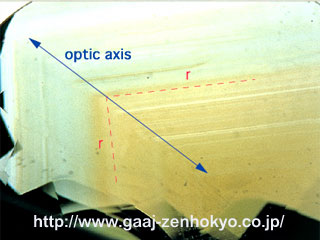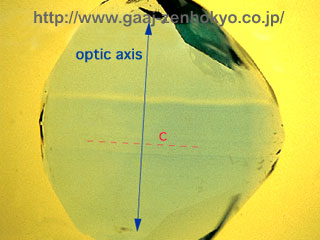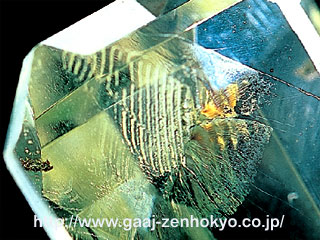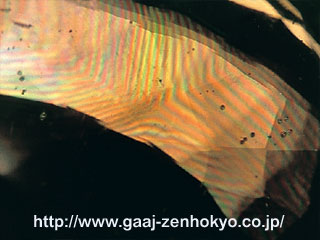|
Synthetic Green Quartz
Synthetic green quartz was firstly reported in the United States in 1954. Its commercial production has started in 1960s and most of them have been manufactured in Russia. Bi-colour material in yellow and green, and multi-colour in purple, yellow and green, were synthesised in 1995 and 1997 respectively. Common crystal habits seen in natural quartz varieties are shown in the figure 2. A crystal consists of a pyramid containing three alternately appearing large (r) and small (z) rhombohedral faces and six prisms (m). The base (c) is rarely seen in a natural crystal,
because the c-face has higher growth rate than other crystal faces. When one crystal face grows faster than the others in the same period, the face gradually reduces its area on the crystal form and eventually disappears. Contrary to this, synthetic quartz varieties generally grow c-face prominently. This is because a seed crystal has been used for commercial mass production to obtain large and clean crystal in shorter period. When a seed crystal in the direction parallel to the c-face of higher growing rate is used for synthesis, the quartz grows in shorter period as the c-face grows large. Such difference in rough crystal makes distinction between natural and synthetic quartz easy. However, the situation is often more complicated, as the stones generally have been cut and polished for gem use. The original crystal form may yet be possible to speculate by carefully inspecting allocation of a face along colour zoning to help identification of the crystal. Colour zoning in the directions intersecting almost at right angle to each other are seen in natural green quartz (greened amethyst), while colour zoning seen in synthetic green quartz is in one direction perpendicular to the c-axis (optic axis). Natural green quartz (greened amethyst) also shows feather inclusion, which is related to Brazil twinning that is a characteristic feature of natural amethyst before heating, or shows unique interference figure (Brewster fringe) under crossed polarising lights.
So-called ggreened amethysth is produced by heating amethyst from certain localities and a rather unusual material. Naturally coloured green stone does rarely occur in some area, but it cannot be identified from those artificially heated. Recently large amount of quartz in green colour was for sale, which actually has been artificially irradiated and not eligible to be given the name ggreened amethysth. Synthetic green quartz is now manufactured on commercial bases. Although this material is difficult to identify visually, identification becomes possible by thoroughly observing colour zoning related to crystal habit of its rough crystal and interference image related to Brazil twinning. References Paradise T.R. (1982) The Natural Formation and Occurrence of Green quartz. GEMS & GEMOLOGY, Vol. 18, No. 1, pp. 39-42. |
||||||||||||||||
|
||||||||||||||||




